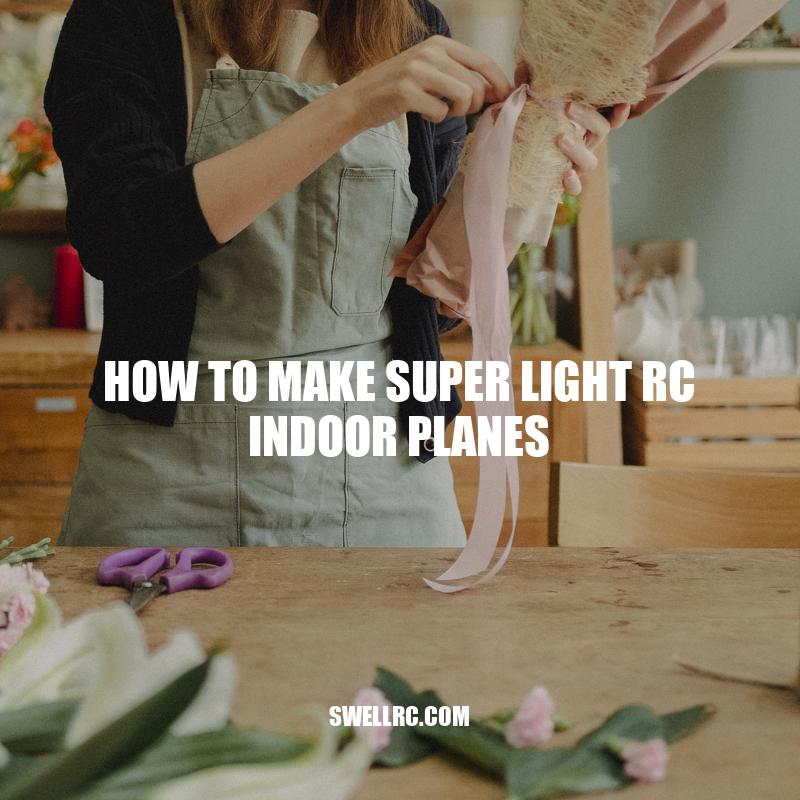Building Super Light RC Indoor Planes: A Step-by-Step Guide
RC indoor planes have become increasingly popular in recent years, and for good reason. Indoor flying offers a unique challenge to pilots, with limited space and obstacles to navigate. To be successful, pilots need a lightweight and agile plane that can maneuver quickly and efficiently. Building your own super light RC indoor plane can be a rewarding experience, allowing you to customize your design and hone your skills as a pilot. In this article, we will guide you through the steps to make your own super light RC indoor plane, from selecting the right materials to adding finishing touches. Whether you’re a seasoned pilot looking to try something new or a beginner looking for a fun and engaging hobby, this guide is for you. Let’s get started!
Materials and Tools
When it comes to building a super light RC indoor plane, selecting the right materials and tools is crucial. Here are some recommended materials and tools to make your own RC indoor plane:
Materials:
- Foam (EPS foam or Depron foam)
- Balsa wood
- Carbon fiber rods or strips
- Thin wire (for reinforcement)
- Transparent tape
- Motor and propeller (for powered planes)
Tools:
- Hobby knife
- Scissors
- Ruler
- Sandpaper
- Soldering iron (for powered planes)
If you’re not sure where to find these materials and tools, there are several online retailers that specialize in RC airplane supplies. Websites such as Horizon Hobby, Great Planes Model Distributors, and Tower Hobbies offer a wide variety of materials and tools for building RC planes. Additionally, you can find tutorials and guides on these websites to help you along the way.
Design and Planning
Designing and planning your super light RC indoor plane can be just as important as the building process. Here are some steps you can follow:
Design
- Decide on the type of plane (glider, powered, etc.)
- Sketch your design on paper or use 3D modeling software
- Ensure your design is aerodynamic and light
- Consider adding dihedral wings for stability
- Design the plane with the size of the indoor space in mind
Planning
- Choose the materials and tools based on your design
- Allocate time for building, testing and making adjustments
- Consider purchasing or building a flight simulator to help you test your plane’s performance
- Make a checklist of all the items you need to purchase or gather
It is important to keep in mind that the design of your plane can impact how it performs in the air. Interestingly, the weight to lift ratio can be stated as lbs./sq.ft. Here is a table of approximate weight and wing loading for different types of RC planes:
| Type of Plane | Approximate Weight | Wing Loading |
|---|---|---|
| Glider | 1-2 oz. | 1-3 oz./sq.ft. |
| Indoor Rubber-Powered | 1 oz. | 3-5 oz./sq.ft. |
| Electric Indoor | 1-2 oz. | 5-8 oz./sq.ft. |
| Outdoor Electric | 3-8 oz. | 10-25 oz./sq.ft. |
By following the steps outlined in the design and planning stage, you can ensure that your plane has a good weight to lift ratio and will fly well in the indoor space.
What is the lightest material for RC planes?
- The lightest material for RC planes is foam, specifically polystyrene foam, which is both lightweight and strong.
- Another option is balsa wood, which is also lightweight but not as durable as foam.
- Carbon fiber and fiberglass are also lightweight materials used in high-performance RC planes, but they can be expensive and more difficult to work with compared to foam or balsa wood.
Several online stores like HobbyKing, Tower Hobbies, and Motion RC offer a wide range of RC planes made of various materials.
Building the Fuselage
The fuselage is an essential component of your indoor plane, as it holds all the electronics and other components together. Here are some tips on how to build it:
Using Foam
- Cut a strip of foam for the fuselage using a modeling knife
- Create the cross-section of your design and cut along the shape of the foam strip
- Add triangular or rectangular bulkheads to reinforce the fuselage
- Add an opening at the front or back of the fuselage for the motor mount, battery holder, etc.
- Sandpaper the edges of the fuselage to make it smooth and round
Using Balsa Wood
- Cut a stick of balsa wood to the desired length for the fuselage
- Add triangular or rectangular bulkheads to reinforce the fuselage
- Create the channel for the electronics, and leave an opening at the front or back for the motor mount, battery holder, etc.
- Sandpaper the edges of the fuselage to make it smooth and round
Another option is using carbon fiber as it is very light and strong. However, it can be more expensive compared to foam or balsa wood.
If you are new to building planes, it may be helpful to use pre-made fuselage and wing kits that can be purchased online or at hobby stores. These kits come with everything you need to build the plane, including foam or balsa wood parts that have already been cut to size. This can save you time and ensure that all the components fit together properly. You can check out some great fuselage kits at Amazon or your local hobby store.
What is the best material for a fuselage?
Some of the best materials for a fuselage in modern aircraft include:
- Aluminum alloys – strong, light and offers good corrosion resistance, but requires coatings to protect against fatigue
- Composites – lightweight, strong, corrosion-resistant, but expensive to manufacture and repair
- Titanium alloys – strong, lightweight, corrosion-resistant, but expensive and difficult to work with
In summary, the best material for a fuselage depends on the specific needs of the aircraft in terms of weight, strength, cost, and maintenance. For more information on aircraft materials, check out websites such as Boeing’s Materials and Fabrication handbook or Aircraft Materials.
Assembling the Wings
The wing is responsible for providing lift to your indoor plane, so it’s important to ensure it’s lightweight and has good aerodynamics. Here’s how to assemble it:
Using Foam
- Draw the wing using a ruler onto the foam sheet, and cut it out with a modeling knife
- If you want more stability, insert a carbon or wood spar into a wing foam
- Curve the leading edge of the wing to help with aerodynamics
- Sand the edges of the wing to make it smooth and also to round the corners
Using Balsa Wood
- Draw the wing using a ruler onto the balsa wood, and cut it out with a modeling knife
- If you want more stability, insert a carbon or wood spar into a wing foam
- Shape the airfoil by sanding the upper surface of the wing to curve it
- Sand the edges of the wing to make it smooth and also to round the corners
It’s important to ensure that both wings are identical for proper balance and stability during flight. You may also want to add winglets or wing tips to improve lift and reduce drag.
There are also pre-made wing kits available for purchase online or at hobby stores. These kits come with foam or balsa wood wings that have already been cut to size and sanded, so you can focus on assembling the rest of the plane. Check out Horizon Hobby for a wide selection of wing kits.
What is the Best Foam for RC Wings?
When it comes to building RC wings, choosing the right foam is crucial to ensure your aircraft’s stability and durability. Here are some of the best foam options for RC wings:
- Balsa: Lightweight and easy to shape, balsa wood is a popular choice for RC wings especially for models with smaller wingspans.
- EPS: Expanded polystyrene (EPS) is a common foam type used in RC planes due to its lightweight, durability and easy availability.
- XPS: Extruded polystyrene (XPS) has a smoother surface and structure than EPS, making it ideal for higher precision projects.
- Carbon Fiber Foam: Carbon fiber foam has a high strength-to-weight ratio, and is often used in high-performance models.
It’s important to note that the type of foam you choose will largely depend on your specific project and budget. Research and compare different foam options before making a final decision. If you’re unsure about which foam to use, consider consulting with an experienced RC builder or professional supplier.
Finishing Touches
Once your fuselage and wings are assembled, it’s time to add the motor, propeller, and any other finishing touches. Here’s what you need to know:
Adding the Motor and Propeller
- Attach the motor mount onto the fuselage using glue or tape
- Secure the motor onto the motor mount and attach the propeller to the motor shaft
- Make sure the propeller is centred and the blades are at the correct angle (most kits come with a recommended angle)
Attaching the Wings and Balancing
- Secure the wings onto the fuselage using glue or tape
- Make sure the wings are level, symmetrical, and straight
- Add weight, such as small coins or lead tape, to the nose or tail of the plane as needed for balance
Adding Decorative Elements
- Add stickers, decals or paint to your indoor plane to make it stand out
- Make sure to keep it light and avoid adding too much weight
- Customize your plane with personal touches such as racing stripes, logos, or designs
Before test flying your indoor plane, it’s important to check that everything is securely fastened and balanced. You may want to test glide your plane to ensure that it flies level and straight. With some practice and testing, you can perfect your super light RC indoor plane for optimal flight and enjoyment.
There are various RC plane forums, online communities, and hobby stores where you can ask for advice, share your ideas, and showcase your creations. Kits and materials can also be purchased online or in-store.
How do you attach a propeller?
Attaching a propeller to a motor shaft might seem simple, but it’s crucial to do it correctly to ensure optimal performance and safety. Here are the steps to follow:
- Make sure the propeller fits the motor shaft snugly, and check its rotation direction before attaching it.
- Apply a small amount of lubricant to the shaft to ensure the propeller slides on smoothly.
- Align the propeller with the shaft, and push it firmly onto the shaft until it seats completely.
- Tighten the propeller nut with a wrench or pliers until it’s snug, but not too tight.
- Check the propeller’s rotation direction again to make sure it matches the motor’s rotation direction.
If you’re unsure about any step, refer to the manufacturer’s instructions or consult a professional. For more information on motor propulsion and propeller installation, visit websites such as BoatUS or West Marine.
Conclusion
Building a super light indoor RC plane is a fun and rewarding DIY project for beginners and seasoned enthusiasts alike. By using lightweight materials, designing and planning your plane, and adding the finishing touches, you can create your very own custom plane for indoor flying. Remember to test glide and balance your plane before taking it for its first flight.
With some practice and experimentation, you can improve your plane’s agility, performance, and appearance. Joining RC plane communities and reading blogs can also help you stay up-to-date on the latest designs, techniques, and technologies.
So why not get started today? With a bit of patience, creativity, and skill, you can build a super light RC indoor plane that will provide endless hours of entertainment and excitement.



